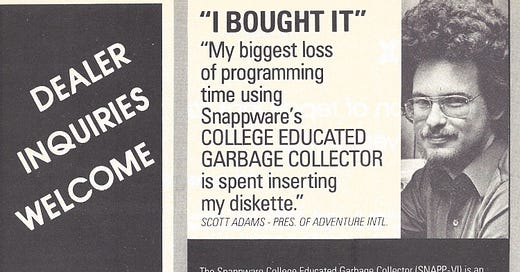The Company
Snappware was founded on November 28th, 1983 by Bob Snapp of Cincinnati, Ohio. (I’ve also seen it written at Snapp-Ware and Snapp Inc.) According to the records that the Ohio Secretary of State has on file, it appears that the company was dissolved in 1988 when they failed to renew the original filing.
Interestingly, it looks like Snappware was operating as early as 1981. The earliest ad I found for the company was in the July 1981 issue of 80 Microcomputing.
The Product
According to the May 1985 issue of Byte Magazine, “Snapp-VI, a string space management utility for the TRS-80 Models II and III.”
For a more in-depth look at the SNAPP product line, the 1984 Omni Complete Catalog of Computer Software has a lot to say:
SNAPP BASIC is a family of enhancements to TRS-80 Microsoft BASIC. SNAPP-II Extended BASIC is the product reviewed here. Other members of the series include SNAPP-III Extended Built-in Functions, SNAPP-IV Extended BASIC Mapping Support (a screen handler), SNAPP-V Extended File Mapping Support, SNAPP-VI College Educated Garbage Collector, and SNAPP-VII Reverse Compression (BASIC program pretty printer). An excellent way to try the SNAPP products is to buy the $35 trial package, which contains limited use versions of the entire family.
SNAPP-II Extended BASIC is a collection of utilities designed to speed BASIC program development and debugging. Single step with trace lets you step through a BASIC program a line at a time. SNAPP-II lets you enter 12 common BASIC commands with a single keystroke, including Edit and List Two cross-referencing commands combine to find references to program variables, constants, character strings, and BASIC keywords. The XDump lists your variables and their current values to the printer or screen. A fast renumbering utility does all the usual things and also lets you move or duplicate blocks of your program. XCompress can strip your program of unnecessary remarks, blanks, tabs, colons, Lets, double-quote marks, GoTos, characters beyond two in variable names, unreachable code fragments, variable-type punctuation marks, and variables in Next statements. It also renumbers your program in a tight increment-by-one fashion, and can merge multiple lines into equivalent singles.
The main differences between the SNAPP utilities and their counterparts found in some TRS-80 operating systems are completeness and speed. As the details given above for the XCompress utility show, SNAPP squeezes the last bit of performance and function out of your machine. The overall combination of SNAPP utilities is expensive, and probably will appeal mostly to those who program for pay. On the other hand, you can buy the trial package for very little money, and add the utilities you like as you see fit. The price of the trial package is applied against your purchase.
Rick Lederman wrote a review entitled “Making BASIC a Snapp” for the January 1982 issue of 80 Microcomputing. “If you spend 20 to 60 hours per week at a Model II developing complex programs in Basic, you've probably already discovered Snapp, Inc.'s Extended Basic Enhancements. They solve some of the more frustrating problems with the Model II Basic interpreter…I thought I had seen it all until I received Snapp IV, their Extended Basic mapping support.”
I found another review that focused specifically on SNAPP-VI. It was written by Arnold Fischthal for the April/May issue of two/sixteen magazine. It states:
Anyone who has ever written an application for the Model II, 12, or 16 that makes extensive use of strings and string manipulations knows, perhaps sadly, how Radio Shack s version of BASIC handles the chore of string reorganization.
…
SNAPPWARE to the rescue! SNAPPWARE has developed a product they have dubbed the "College Educated Garbage Collector" (CEGC). This machine language routine in most applications will replace the BASIC string reorganization with one that is immensely faster.
…
This reviewer has had occasion to write programs that use extensive string manipulations and has found that time delays of 15-30 seconds were reduced to .5-2.0 seconds, making the reorganization almost transparent to the operator.
The performance of this product lived up to all the claims made for it. The documentation was excellent, and its implimentation in any application program was quite simple.
The service provided by SNAPPWARE with regard to questions on their products is excellent.”
Extra Info
Are you curious about the guy in the ad with the magnificent hair? No, it’s not the Scott Adams of Dilbert fame before he lost his hair. This Scott Adams was a pioneer in the world of interactive fiction. You can find more information here.
Did you ever use any Snappware products? Do you know anything about its history? Tell us about it in the comments below.
What computer ads would you like to see in the future? Please comment below. If you enjoyed, please share with your friends and relatives. Thank you.





